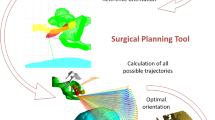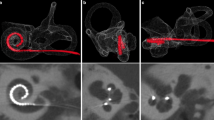Abstract
Purpose
Evaluation of 3D Dyna-CTs to improve cochlear implantation (CI) planning and intraoperative electrically elicited stapedius reflex threshold (ESRT) measurements.
Methods
A prospective observational cohort study was performed. Anonymized data collection of Dyna-CTs and CI surgeries in which a retrofacial approach was implemented to access the stapedius muscle. 3D Dyna-CTs of 30 patients and the intraoperative confirmation of the predication in 5/30 patients during CI surgery were evaluated. Inter-rater reliability was also analyzed along with the predictive value of this evaluation.
Results
36 representative structures of the middle and inner ear and 3D renderings of the Dyna-CTs were evaluated by four otoneurological surgeons. Fleiss’ kappa values for the evaluation of the visibility were high (> 0.7) for most of the anatomical structures. The stapedius muscle was visible in 90% of the cases. Using the 3D data, the retrofacial access to the stapedius muscles was estimated as feasible in 86.7%. Fleiss’ kappa value of the evaluation of the accessibility was 0.942. The intraoperative exploration of the stapedius muscle confirmed the preoperative prediction in all five selected patients (four patients with predicted accessibility and one patient with predicted inaccessibility).
Conclusions
The use of Dyna-CT and 3D rendering is a helpful tool for preoperative planning of cochlear implantations and ESRT measurements from the stapedius muscle via the retrofacial approach.






Similar content being viewed by others
References
Piergallini L, Scola E, Tuscano B et al (2018) Flat-panel CT versus 128-slice CT in temporal bone imaging: assessment of image quality and radiation dose. Eur J Radiol 106:106–113
Ruivo J, Mermuys K, Bacher K et al (2009) Cone beam computed tomography, a low-dose imaging technique in the postoperative assessment of cochlear implantation. Otol Neurotol 30:299–303
Theunisse HJ, Joemai RM, Maal TJ et al (2015) Cone-beam CT versus multi-slice CT systems for postoperative imaging of cochlear implantation—a phantom study on image quality and radiation exposure using human temporal bones. Otol Neurotol 36:592–599
Posadzy M, Desimpel J, Vanhoenacker F (2018) Cone beam CT of the musculoskeletal system: clinical applications. Insights Imaging 9:35–45
Guyader E, Savean J, Clodic C et al (2018) Three-dimensional reconstruction of the temporal bone: comparison of in situ, CT, and CBCT measurements. Eur Ann Otorhinolaryngol Head Neck Dis 135:393–398
Kennedy TA, Connell N, Szczykutowicz T et al (2016) Flat-panel CT for cochlear implant electrode imaging: comparison to multi-detector CT. Otol Neurotol 37:1646–1653
Zaoui K, Kromeier J, Neudert M et al (2014) Clinical investigation of flat panel CT following middle ear reconstruction: a study of 107 patients. Eur Radiol 24:587–594
Jun BC, Song SW, Cho JE et al (2005) Three-dimensional reconstruction based on images from spiral high-resolution computed tomography of the temporal bone: anatomy and clinical application. J Laryngol Otol 119:693–698
Noble JH, Dawant BM, Warren FM et al (2009) Automatic identification and 3D rendering of temporal bone anatomy. Otol Neurotol 30:436–442
Pau HW, Zehlicke T, Sievert U et al (2009) Electromyographical recording of the electrically elicited stapedius reflex via a bipolar hook electrode. Otol Neurotol 30:1–6
Chuang MT, Chiang IC, Liu GC et al (2006) Multidetector row CT demonstration of inner and middle ear structures. Clin Anat 19:337–344
Van Den Abbeele T, Noel-Petroff N, Akin I et al (2012) Multicentre investigation on electrically evoked compound action potential and stapedius reflex: how do these objective measures relate to implant programming parameters? Cochlear Implants Int 13:26–34
Andrade KC, Leal Mde C, Muniz LF et al (2014) The importance of electrically evoked stapedial reflex in cochlear implant. Braz J Otorhinolaryngol 80:68–77
Weiss BG, Sochting F, Bertlich M et al (2018) An objective method to determine the electrically evoked stapedius reflex threshold during cochlea implantation. Otol Neurotol 39:e5–e11
Pulec JL (1996) Sinus tympani: retrofacial approach for the removal of cholesteatomas. Ear Nose Throat J 75:77, 81–3, 6–8
Yilmazer R, Gerring RC, Sidani C et al (2018) The feasibility of retrofacial approach for cochlear implantation. Otol Neurotol 39:e550–e556
Rizk H, O'Connell B, Stevens S et al (2015) Retrofacial approach to access the round window for cochlear implantation of malformed ears. Otol Neurotol 36:e79–83
Schneider D, Stenin I, Anso J et al (2019) Robotic cochlear implantation: feasibility of a multiport approach in an ex vivo model. Eur Arch Otorhinolaryngol 276:1283–1289
Acknowledgements
We thank Francesca Maule and Pedro Alexander Marquez Vergara for their help with the image data management and segmentation of the Dyna-CTs.
Funding
The development of the 3D Dyna-CT segmentation algorithm was sponsored by MED-EL Elektromedizinische Geräte GmbH, Innsbruck, Austria.
Author information
Authors and Affiliations
Corresponding author
Ethics declarations
Conflict of interest
All authors declare that they do not have conflict of interest. The funders had no role in study design, data collection and analysis, decision to publish, or preparation of the manuscript. Orlando Guntinas-Lichius wrote the first draft of the manuscript. No honorarium, grant, or other form of payment was given to anyone to produce the manuscript.
Ethical approval
All procedures performed in studies involving human participants were in accordance with the ethical standards of the institutional and/or national research committee and with the 1964 Helsinki Declaration and its later amendments or comparable ethical standards.
Additional information
Publisher's Note
Springer Nature remains neutral with regard to jurisdictional claims in published maps and institutional affiliations.
Electronic supplementary material
Below is the link to the electronic supplementary material.
405_2019_5773_MOESM1_ESM.docx
Supplement Figure 1. 3-D visualization of the temporal bone in correspondence to the Dyna-CT in three planes as available during evaluation. Green = inner ear (cochlea, semicircular ducts); yellow = facial nerve and chorda tympani; red = stapedius muscle. The cube is an orientation marker: R = right; I = inferior; A = anterior. (DOCX 448 kb)
Rights and permissions
About this article
Cite this article
Volk, G.F., Aschenbach, R., Gadyuchko, M. et al. Dyna-CT of the temporal bone for case-specific three-dimensional rendering of the stapedial muscle for planning of electrically evoked stapedius reflex threshold determination during cochlear implantation directly from the stapedius muscle via a retrofacial approach: a pilot study. Eur Arch Otorhinolaryngol 277, 975–985 (2020). https://doi.org/10.1007/s00405-019-05773-2
Received:
Accepted:
Published:
Issue Date:
DOI: https://doi.org/10.1007/s00405-019-05773-2




